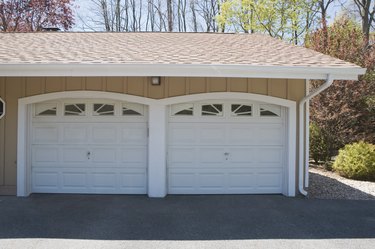 Paint with accent colors, such as on doors, after the main color is dry. Image Credit: Thinkstock Images/Comstock/Getty Images
Paint with accent colors, such as on doors, after the main color is dry. Image Credit: Thinkstock Images/Comstock/Getty Images
A fresh coat of paint brightens your home's curb appeal, but garages need love, too. On a day with mild, clear weather, a paint sprayer lets you freshen up fading paint or apply a whole new color. Avoid painting in direct sunlight or when it's windy. The sun's heat can cause bubbling, and wind sends paint particles far away from where you want them.
Tip
Sponsored tip: Need tools for your project? Check out RentalHQ and get connected with local businesses that’ll help you rent the equipment and tools you need.
Clean the Exterior
For a tidy, even paint job, begin with a clean slate. Pressure washing works for most exteriors, but use a light touch and hold the nozzle downward to avoid scarring the surface and lifting siding, if any exists. Garages constructed from concrete blocks are candidates for effective pressure washing. If you don't have a pressure washer, scrubbing the exterior with a soft-bristle scrub brush and a weak solution of detergent and water does the trick. Correct light rust by abrading the surface gently with fine steel wool. Paint won't stick properly on a damp surface, so let the garage dry before painting.
Protect Areas You Don’t Wish to Paint
Paint sprayers create a fine mist that can overspray onto other areas, and even a light breeze can direct particles toward gutters, roof shingles and the foundation. Just as you'd tape off and protect interior areas before painting, do the same on the exterior of the garage. Thin plastic sheeting and painter's tape protects large areas such as windows, doors, the foundation and main garage bay door, if you don't wish to paint it. If the gutters don't need paint, protect them with brown paper and painter's tape. Paper also covers objects such as utility meters and outdoor water spigots and it provides a less slippery surface than plastic when spread out over steps. Guard against painting the landscaping by draping a few old sheets over shrubs and flower beds. Plastic can cause the plants underneath to overheat.
Manual Tools for a Better Result
The lack of precision with a paint sprayer means you'll still need a few manual tools. Painter's tape helps create straight, clean lines, but it's best to cut in around the edges with a trim paintbrush. Cutting in also lets you keep the sprayer at a greater distance from areas where you can't or don't wish to tape off. Although paint rollers aren't required when using a sprayer, they're valuable tools that create a better result on porous surfaces. After spraying an area, rolling over it once with a saturated paint roller helps force paint into textures such as stucco, concrete and raised wood-grain patterns on some siding.
Safety and Setup
Air atomized paint sprayers perform well as general purpose tools. If yours is a high-pressure airless sprayer, never point it at your body. Airless sprayers can inject paint through clothing and into the skin. Every sprayer operates a bit differently and requires a slightly different setup. Most require thinning paint with water or another thinner, and the manufacturer's directions explain precisely which paint-to-thinner ratio is required for that tool. Some sprayers use hoses that require priming with paint. When selecting a paint sprayer tip, opt for one that produces a wide spray for large areas rather than a narrow, concentrated one. Safety goggles, a dust mask and gloves protect you against the fine particle mist.
Spraying Techniques
The difference between average and good paint sprayer results is technique. Working in horizontal rows from the top of a wall to the bottom, wide, sweeping passes apply paint more evenly than short, choppy strokes. To prevent obvious demarcation lines, start moving your arm before squeezing the trigger, and keep moving your arm in the same direction after the trigger is released. This creates feathered edges at the beginning and end of each pass. Holding the sprayer upside down to paint under the lipped edge of each row of siding lets paint reach into the seams. In all cases, keep the sprayer moving; hold in one spot for even a few seconds and you'll get thick areas that run and drip. Most surfaces need a couple of coats of paint, but peel off tape and plastic or paper as soon as you can afterward. Tape left overnight can result in gummy residue when you peel it off.


